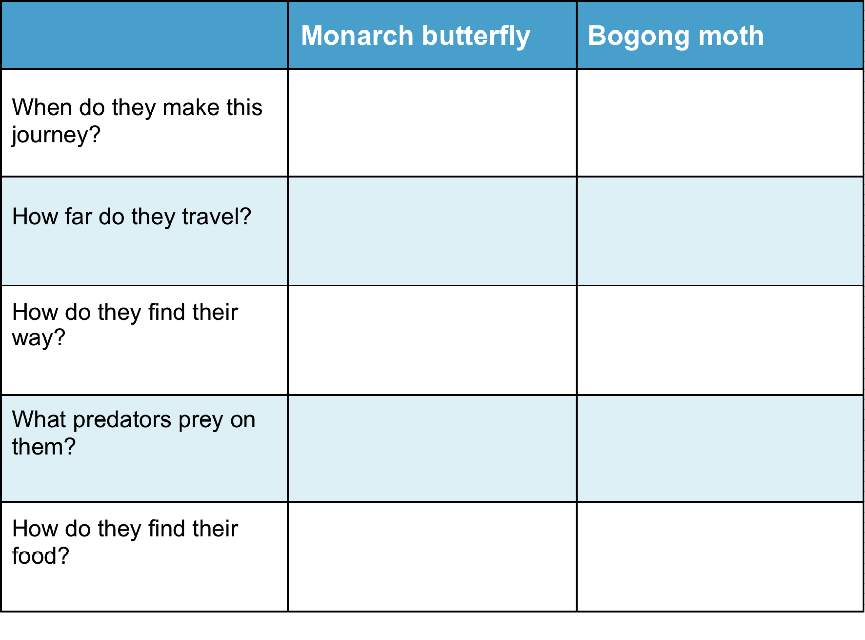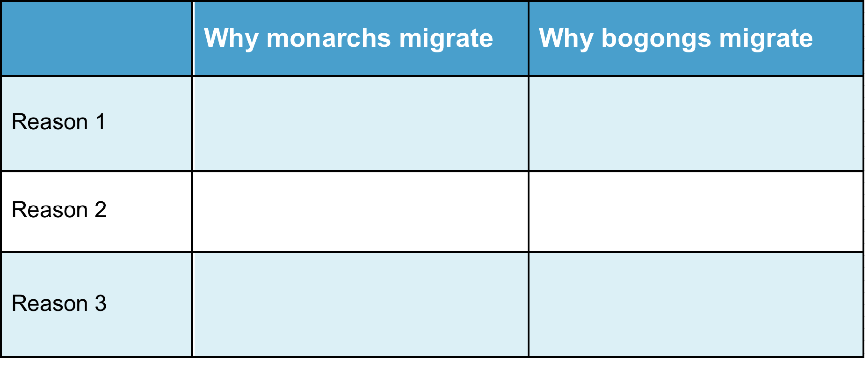Information for Teachers
Curriculum links
Australian Science Standards
BS (ACSSU72) Observations of living things as they move through their life cycles
BS (ACSSU72) Stages of life cycles of different living things
BS (ACSSU73) Plants provide shelter for animals
NDS (ACHSHE061) Science involves making predictions and describing patterns and relationships
New Zealand Science Achievement Objectives
LW: The interdependence of living things in an ecosystem
LW: The key structural features and functions involved in the life processes of plants and animals
NS: Scientists’ investigations are informed by current science theories and aim to collect evidence that will be interpreted through processes of logical argument
Helpful websites
You may want to direct your students to some or all of these websites to help with their investigations.
Journey North allows you to report and follow reports of sightings of monarchs:
http://journeynorth.org/monarch/
The Wild Center has a section on science that deals with the monarchs and people who have spent their lives studying monarch behavior:
http://www.wildcenter.org/science/all-about-monarchs-2/?gclid=Cj0KEQiAlsrFBRCAxcCB54XElLEBEiQA_ei0DJXF1nhCu2LfD0wEoc8MZfy2vkGXQv_sTawMERCEBXsaAjta8P8HAQ
Ask a Biologist has lots of useful information including an animation showing where the insects travel:
https://askabiologist.asu.edu/monarch-migration
How to search the internet
1 Keep your request short
Fewer words will give a more accurate search.
2 Choose exactly what you want
For example: Arctic Circle Climate
3 Use quotes
Double quotes around a set of words tell the search engine to consider those exact words in that exact order without any change. For example: “Arctic Circle Climate”
4 Use the plus sign (+)
If you add a plus sign (+) between words, the internet will search for all the words. For example: migrate+birds+whales+mammal
5 Use the minus sign (–) to say what you don’t want
Use a minus sign (–) to show words you do not want to appear in your results. For example: if you search for burrowing animals and do not want mammals in your search, –mammals will exclude mammals. Note that you need to put a space before the minus sign for the word to be excluded.
6 Be very clear about what you don’t want
Part 1
Ask questions and make predictions
After reading Insects on the Move, you may have many questions about these insects.
List your questions
- Compare your list with questions that others have.
- Choose a question you would like to investigate.
- You can work alone, with a partner, or in a small group.
You may want to choose one or more of these questions to investigate
Q1. How do the monarchs that migrate to Mexico find their way? Find different explanations that people have given.
Q2. Compare the migrations of the monarch butterfly and the bogong moth. What is different and what is the same about their journeys?
Go to Part 2 Plan and investigate →Part 2
Plan and investigate
Do searches in the internet or in books or talk to people who can help to find the information you are looking for.
Your teacher may suggest suitable websites for further information.
Go to Part 3 Record and analyse data →Part 3
Record and analyse data
Find a way of recording your information that will allow you to see any patterns in the data.
Data chart for insects on the move
 Download Chart
Download Chart
Go to Part 4 Evaluate the information →
Part 4
Evaluate the information
1. Look over the information you have gathered and the patterns you have found.
Why do you think these insects migrate to these different places at different times? Why do they need to do this?
2. Search for other patterns.
How far did the monarchs travel in different seasons?
How far did the bogongs travel in different seasons?
3. Makes notes about what you find.
Go to Part 5 Communicate and share ideas →Part 5
Communicate and share ideas
Look over all of the information that you have gathered in your investigation.
What are the most important ideas about the migration of monarchs and bogongs?
Make a chart showing the most important ideas.
 Download Chart
Download Chart
← Return to menu
